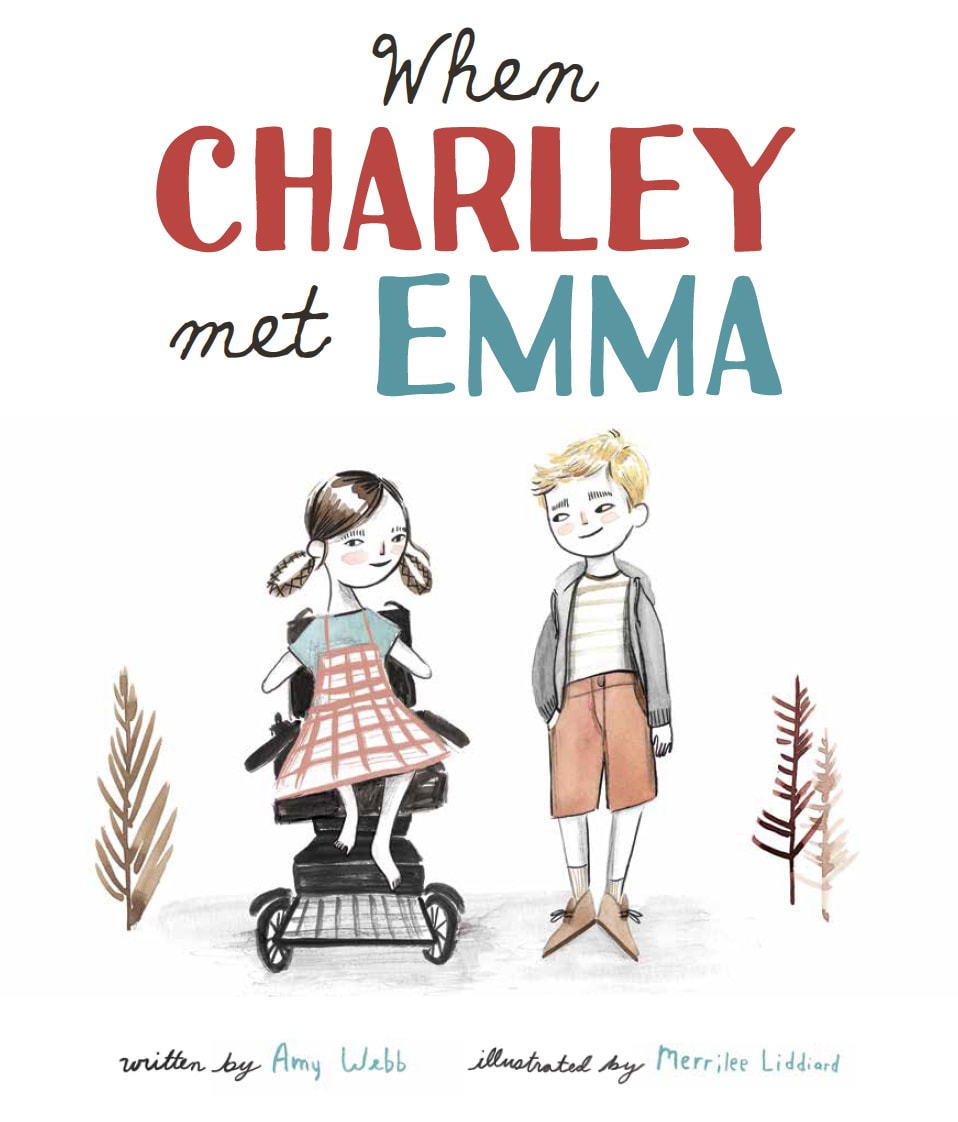It’s the first year I genuinely am not ready for the kids to go back-to-school. I could easily have taken another 2-3 weeks of summa summa summatime. But regardless, the time for newly sharpened yellow pencils, early alarm clocks and the tedium of packing lunches day after day until the end of time is upon us.
Each year around this time I share my posts for talking to you kids about their special needs peers, and today I’m going to do the same. As part of this discussion I want to share with you WHY I wrote my upcoming children’s book, When Charley Met Emma, that also aims to be a teaching tool to help children learn about disability as it is a part of the same conversation.
Back-To-School + Teaching About Disability
But first, lets talk about this wonderful opportunity back-to-school time presents for talking to our kids about their special needs peers. Many parents take the time to teach their children about kindness and inclusion this time of year, which is wonderful! I think it’s important to continue to do that. I would like to encourage you to stretch that talk a little further by specifically teaching kids about disability. It is simply not enough to tell kids to be nice and kind when it comes to encountering children who have disabilities, especially when their young and inexperienced minds have never encountered someone with differences before. Children have questions! And concerns! And how’s and whys and all sorts of stuff. It’s really, really hard to remember to “be nice” when you’re also trying to comprehend wheelchairs, limb differences, atypical movements or sounds, leg braces, walkers or any number of things that set our special needs kids apart.
The best resource I have for leading a discussion with your children is a post I wrote called Talking To Your Children About Disability. This post includes the main bullet points to cover with your children as well as including many links to videos and posts about other kids with disabilities so that they can really get a sense for the variety of differences out there–what those differences look like, and how they manifest in people. Honestly, kids are genuinely curious and even fascinated by disability and that’s OK! Use that curiosity to demystify disability and to teach them about the great variety of the human condition. Personally, I think it’s beautiful and amazing point of view.
I was recently interviewed in a podcast produced by Slate Studios in Partnership with Target teaching parents my four step plan for how to navigate a special needs encounter. I was interviewed by the fabulous Mallory Kasdan of the popular MILK podcast (Moms I’d Like to Know) and you can listen here, on iTunes or anywhere you get your podcasts! Also featured in the series are designer and entrepreneur Joy Cho of OhJoy.com fame and director Morgan Neville director of the Mr. Rogers documentary, Won’t you Be My Neighbor.
Now about the book. You may remember that back in March I made the exciting announcement that I wrote a children’s book and that it was getting published! In that post I detail how the book came about and what it took to make this dream a reality. More recently, I got to share the cover of the book, illustrated by Merrilee Liddiard, which means the title, When Charley Met Emma, was also revealed. That was a very exciting day for me!However I didn’t specifically talk about why I wrote this book. Of course the whys are all throughout this blog and the many things I’ve written over the years, but I want to be clear and specific about why I felt the need to specifically write and pursue the publishing of a children’s book that features a main character with a prominent disability.
One of the whys, of course, is so that parents will have a beautiful, educational and interesting teaching tool to help teach their children about diversity. The idea is that you won’t necessarily have to sit down and have “the talk” about disability with your children because it will be a natural part of your kids exposure to difference at an early age and part of an on going conversation. If children have a book with characters who have limb differences or other disabilities they won’t be startled when they see a person in real life with similar differences. They will have a point of reference to help their young minds comprehend the beautiful truth that disability is a normal part of their world.
But lets take this a little further.
I wrote When Charley Met Emma with the hopes that one day my daughter can go to college, get a job, support herself, find accessible housing, get married and have kids (if she so chooses).
How does writing a children’s book featuring a child with disabilities help Lamp got to college, get a job and get married?
Because REPRESENTATION MATTERS.
When I talk about representation what I mean is seeing yourself (ie people who look, think, talk, act, believe and live like you) represented in the world around you (ie in movies, television, advertisitng, magazines, books, pictures books and the media at large). Because when we see people like us in the media we consume it translates into our real lives.
If that seems like a huge leap to say that having more representation in media will equate to my daughter getting a good job, well… it’s not. If people don’t see you as a part of the world around them, do they see you at all? Are you viewed as a valuable member of society who has much to contribute? According to this article from Huffington Post, no. “There’s this body of research and a term known as ‘symbolic annihilation,’ which is the idea that if you don’t see people like you in the media you consume you must somehow be unimportant.(In a 1976 paper titled “Living with Television,” researchers George Gerbner and Larry Gross coined the term with a chilling line: “Representation in the fictional world signifies social existence; absence means symbolic annihilation.”)
This article from Vice takes it a little further, “Carlos Cortes, a historian who wrote the book The Children Are Watching: How the Media Teach About Diversity, [said],”First, whether intentionally or unintentionally, both the news and the entertainment media ‘teach’ the public about minorities, other ethnic groups and societal groups, such as women, gays, and the elderly,” Cortes wrote. “Second, this mass media curriculum has a particularly powerful educational impact on people who have little or no direct contact with members of the groups being treated.”Audiences—especially those with little exposure to those outside of their community—typically equate these limited, and harsh, media representations with the real world. That, in turn, can lead to “less attention from doctors to harsher sentencing by judges, lower likelihood of being hired for a job or admitted to school, lower odds of getting loans, and a higher likelihood of being shot by police.”
Representation matters.
And here’s the kicker for me. In many articles I referenced for writing about representation (at least 4, including the ones I link to above) not one of them even mentions representation for the disabled. People with disabilities don’t just struggle to be authentically represented in the media–they struggle to be represented in discussions about representation.
I don’t expect my book to be a game changer, but I do hope that it becomes one more cog in the machine toward more representation, which equates to more equality, which equates to more opportunity, which equates to a better quality of life. We need all the voices we can get to move this machine of equality forward. We need the big voices of the media yes, definitely. But more importantly I believe we need the millions of small voices that come from inside the walls of our own homes during dinnertime conversations and bedtime rituals, answering our kids genuine questions about diversity and disability and exposing them to media–(ahem) including children’s books among other things–that will open their little minds to new ways of being in the world.
I genuinely hope we all (myself included) take the time to teach our children about diversity in the world. Because when we teach our children about diversity, diversity teaches them.
In the words of Hannah Gadsby, Diversity is strength. Difference is a teacher.

.jpg)
.png)


I appreciate this roundup – the reminders and the new info. And I wonder whether your family shops Lakeshore toys? We bought the boys several sets of their block play people (mostly because they're classroom grade, and we liked the idea that they might last). One of the block play doll sets is "people with differing abilities." Our oldest son, maybe 4 at the time, noticed that the little girl in the wheelchair did not fit through the Lakeshore store doors. He built her a ramp to get in around the side, but it continued to bother him. We wrote a quick email to the company, who responded immediately.
(longer version of the story here: https://betzfamilycolumbus.blogspot.com/2013/01/lakeshore-listened.html )
I guess what I'm thinking now, is how responsive Lakeshore might be to a limb difference play person – I bet if you wrote to them, they'd give it fair consideration. Just a thought. Just a small step. But worth it.
Also, completely unrelated — if you guys ever come to a Buckeye game, consider this a sincere invitation to the Betz football tailgate party 😉